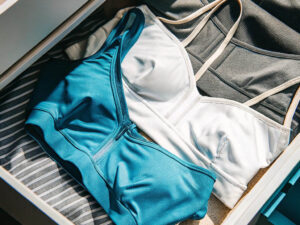We spend hours every day in a bra—but not every bra is doing us a favor. While the right bra can support, shape, and comfort you, the wrong one can lead to pain, irritation, and even long-term health issues. So, which types of bras should you avoid?
Bras that are too tight, poorly fitted, made from non-breathable synthetic fabrics1, or include excessive underwire or padding are considered unhealthy. These bras can cause skin irritation, restrict blood flow, impact posture, and lead to discomfort during prolonged wear.
Let’s dive deeper into which types of bras are best left out of your drawer—and how to spot the signs that a bra is doing more harm than good.
Why can some bras be harmful?
A bra sits directly against your skin and supports sensitive tissue—so if the design or materials are wrong, problems can happen fast.
Wearing the wrong kind of bra can cause physical discomfort, skin issues, poor posture, restricted circulation, and even affect breathing.
Common Risks of Bad Bras:
✘ Breast pain and pressure
✘ Back, neck, or shoulder strain
✘ Skin rashes, chafing, or acne
✘ Red marks from digging straps or bands
✘ Long-term shape distortion of breast tissue
Now, let’s identify which types are most likely to cause these issues.
1. Tight, high-compression bras
Compression is good—but too much can be harmful.
Overly tight sports bras or shapewear bras that compress the chest can restrict breathing and reduce lymphatic flow. This is especially risky if worn for long hours outside of exercise.
Signs It’s Too Tight:
- You feel pressure when breathing deeply
- You get deep marks around your ribcage
- The band rolls up or leaves welts
- You experience numbness or tingling in the shoulders
Tip: A snug fit is fine for workouts—but go for lighter support during downtime.
2. Bras with heavy or rigid underwire2
Support doesn’t have to come with discomfort.
Poorly placed or stiff underwires can dig into your chest, underarm area, or ribs—causing pain or even bruising. In some cases, wires can damage the fabric and poke through, creating injury risk.
Risks of Bad Underwire:
- Irritation of sensitive skin
- Inflammation or clogged ducts (especially during hormonal changes)
- Discomfort during movement or sitting
- Increased risk of pressure on lymph nodes under the arms
Tip: If you prefer underwire bras, choose ones with flexible, cushioned wire and proper fit.

3. Bras made from synthetic, non-breathable materials
Moisture-trapping fabrics are a recipe for skin trouble.
Cheap bras made from 100% polyester or other non-breathable synthetics can trap sweat and heat—leading to chafing, body acne, and fungal infections.
Warning Signs:
- Hot or sticky feeling during wear
- Rashes in the underboob or side areas
- Persistent odor or bacteria buildup
- Itchy skin or flare-ups of existing conditions like eczema
Better Options: Organic cotton, bamboo, modal, or bras with moisture-wicking liners.
4. Overly padded push-up bras
Added volume can come at a cost.
Push-up bras with thick foam padding can distort natural breast shape, cause overheating, and put pressure on breast tissue if worn too often.
Not Ideal For:
- Long wear during hot seasons
- Sensitive skin (foam can retain bacteria and sweat)
- Those looking for a natural shape or flexibility
Tip: Save push-ups for short-term styling, not everyday wear.
5. Ill-fitting bras (wrong size or shape)
Even the best fabric or design fails if the fit is wrong.
Wearing the wrong size bra can lead to neck and shoulder pain, poor posture, and sagging over time. Surprisingly, studies show up to 80% of women wear the wrong bra size.
Signs You’re in the Wrong Size:
- Cups gape or overflow
- Straps dig in or fall off
- The band rides up your back
- You’re constantly adjusting during the day
Fix It: Get fitted by a professional—or measure yourself at home and cross-check with brand-specific size charts.
6. Strapless bras with poor grip or structure
Support matters—even without straps.
Many strapless bras rely on tight bands or sticky silicone to stay in place—but when poorly made, they either slide down or dig in painfully.

Problems They Cause:
- Constant slipping = bad posture
- Silicone strips can irritate or cause allergic reactions
- Over-tight bands compress the ribs
Tip: Invest in a well-structured strapless bra with wide support bands and soft lining.
What are the healthiest types of bras to wear instead?
Let’s flip the script and talk about the bra styles that help, not hurt.
Healthier Bra Types:
✔ Wireless bras / Bralettes – Gentle support, no pressure
✔ Organic cotton bras – Skin-friendly and breathable
✔ Lightly lined bras – Keeps shape without heavy padding
✔ Wide band sports bras – For movement with comfort
✔ Front-closure bras – Easier on shoulders and chest
The goal? Support without restriction—and comfort that lasts.
When should you stop wearing a certain bra?
Trust your body—it tells you when something’s off.
Time to Retire a Bra If:
- It leaves red marks, rashes, or pain
- You feel relief when taking it off
- The shape no longer fits your body
- The wire or band is poking or sagging
- The fabric feels itchy, hot, or too tight
One uncomfortable bra worn daily can lead to months of tension and skin issues.
Conclusion
The worst types of bras are the ones that restrict, irritate, or force your body into unnatural positions. Avoid overly tight compression bras, rigid underwires, non-breathable synthetics, heavy padding, and poorly fitted styles. Instead, choose bras made from soft, breathable materials with a flexible, body-honoring design. Your body will thank you.














